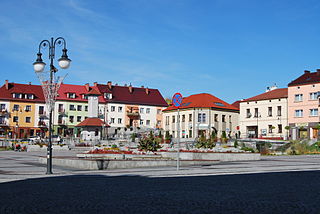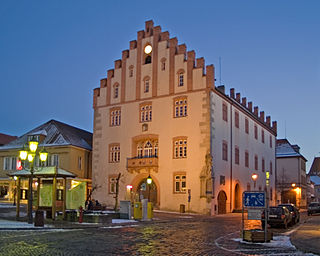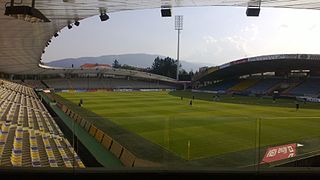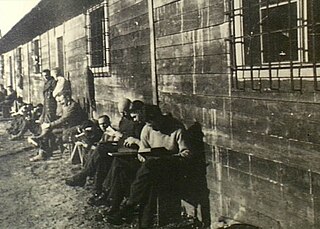
Maribor is the second-largest city in Slovenia and the largest city of the traditional region of Lower Styria. It is also the seat of the City Municipality of Maribor, the seat of the Drava statistical region and the Eastern Slovenia region. Maribor is also the economic, administrative, educational, and cultural centre of eastern Slovenia.

Celje is the fourth-largest city in Slovenia. It is a regional center of the traditional Slovenian region of Styria and the administrative seat of the City Municipality of Celje. The town of Celje is located below Upper Celje Castle at the confluence of the Savinja, Hudinja, Ložnica, and Voglajna rivers in the lower Savinja Valley, and at the crossing of the roads connecting Ljubljana, Maribor, Velenje, and the Central Sava Valley. It lies 238 m (781 ft) above mean sea level (MSL).

Trzebinia is a town in Chrzanów County, Lesser Poland, Poland with an Orlen oil refinery and a major rail junction of the Kraków - Katowice line, with connections to Oświęcim and Spytkowice. The town became part of Lesser Poland Voivodeship after being part of Katowice Voivodeship (1975–1998). With population of 20,175, Trzebinia is an important industrial center. The town lies in the Kraków-Częstochowa Upland, 269 to 407 m above sea level. Trzebinia is a rail and road hub, and lies at a junction of the A4 Motorway and National Road Nr. 79. The distance to John Paul II International Airport Kraków-Balice is 30 kilometres.

Nogometni klub Maribor is a Slovenian professional football club based in Maribor, Slovenia. It competes in the Slovenian PrvaLiga, the top tier of the Slovenian football league system. Nicknamed "The Purples", the club was founded on 12 December 1960. They are regarded as a symbol of Slovenian football, particularly in their home region of Styria in northeastern Slovenia.

Trutnov is a town in the Hradec Králové Region of the Czech Republic. It has about 30,000 inhabitants. The town centre is well preserved and is protected by law as an urban monument zone.

Brežice is a town in eastern Slovenia in the Lower Sava Valley, near the Croatian border. It is the seat of the Municipality of Brežice. The area was traditionally divided between Lower Styria and Lower Carniola. The whole municipality is now included in the Lower Sava Statistical Region.

Hammelburg is a town in Bavaria, Germany. It sits in the district of Bad Kissingen, in Lower Franconia. It lies on the river Franconian Saale, 25 km west of Schweinfurt. Hammelburg is the oldest winegrowing town (Weinstadt) in Franconia.

Stalag VIII-A was a German World War II prisoner-of-war camp, located just to the south of the town of Görlitz in Lower Silesia, east of the River Neisse. The location of the camp lies in today's Polish town of Zgorzelec, which lies over the river from Görlitz.

Ljudski vrt is a football stadium in Maribor, Slovenia, which has a seating capacity of 11,671. It has been the home of NK Maribor since their formation in 1960, with the exception of a short period in early 1961. It was originally the home of several other football teams based in Maribor, including Rapid and Branik. A prominent feature of the stadium is the main grandstand with a concrete arch, which is protected by the Institute for the Protection of Cultural Heritage of Slovenia as an architectural and historical landmark.

Otmuchów is a town in Nysa County, Opole Voivodeship, Poland, with 6,581 inhabitants (2019).

Stalag XVIII-D was a German prisoner-of-war camp located in Maribor in German-occupied Yugoslavia. It opened in the spring or early summer of 1941, operating until the end of the war.
The Raid at Ožbalt was an operation on 31 August 1944 in which 105 Allied prisoners of war (POWs) were rescued by Slovene Partisans. The majority were liberated from a work site at the village of Ožbalt about 25 kilometres (16 mi) west of Maribor on the railway line to Dravograd in the German Reichsgau Steiermark (Styria), now part of modern-day northern Slovenia. Six of the liberated POWs were separated from the group during an engagement with the Germans a few days after their liberation, but following a 14-day trek across 250 kilometres (160 mi) they were flown out of a Partisan airfield at Semič to Bari, Italy. The successful escapees consisted of eight Frenchmen, nine New Zealanders, 12 Australians, and 70 British POWs.

Nogometni klub Branik Maribor, known as NK Branik or simply Branik, was an association football club based in the city of Maribor. Founded on 29 January 1949 they traced their origin back to 1919 and the establishment of I. SSK Maribor, an association football club founded by Slovenian youth which ceased all operations due to World War II. NK Branik was disbanded on 11 August 1960 due to the food poisoning affair before their promotional qualifications match for the Yugoslav Second League against Karlovac. The club colours were black and white.
The following is a timeline of the history of the city of Strasbourg, Alsace, France.
The following is a timeline of the history of the city of Gdańsk, Poland.
The following is a timeline of the history of the city of Wrocław, Poland.
The following is a timeline of the history of the city of Essen, Germany.
The following is a timeline of the history of the city of Linz, Austria.

Ralph Churches BEM was an Australian army private who planned and carried out the biggest and most successful POW escape of World War II. One of eight children, Ralph was a 22-year-old bank teller when he enlisted in the Second Australian Imperial Force's 2/48th Battalion on 14 June 1940.

Nazi Germany operated around 1,000 prisoner-of-war camps during World War II (1939-1945).















